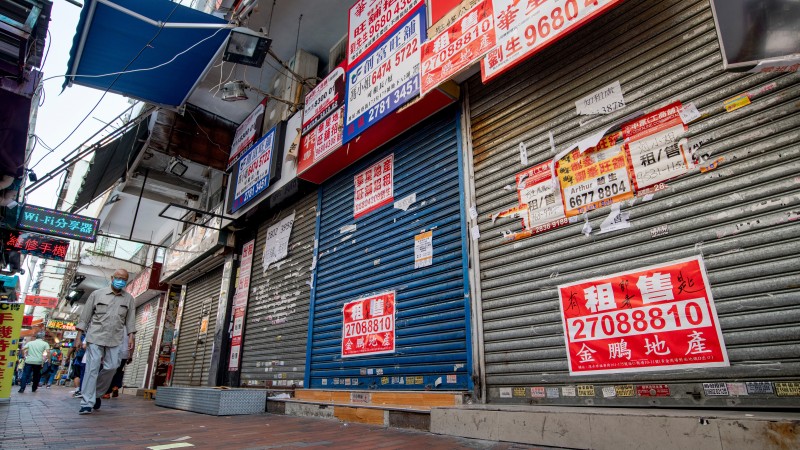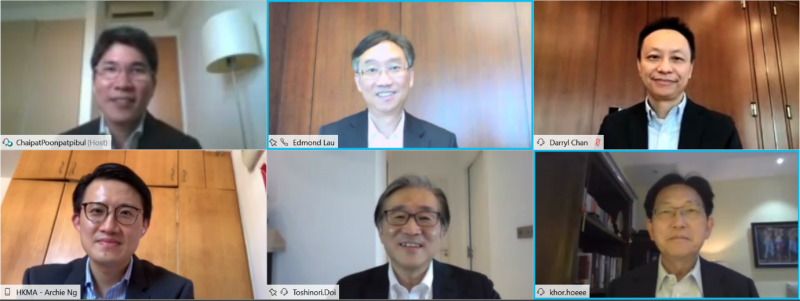
SINGAPORE, July 27, 2020 – Hong Kong’s[1] economy and financial system have remained resilient despite pressures from the U.S.-China tensions, the social unrest in the second half of 2019, and the COVID-19 pandemic. Following a sharp downturn in H1 2020, the economy is expected to stage a recovery toward the end of 2020 and into 2021 on the back of improvements in the global and domestic pandemic situations and aided by supportive policy measures. This is according to the preliminary assessment by the ASEAN+3 Macroeconomic Research Office (AMRO) after its virtual Annual Consultation with the Hong Kong authorities from July 13 to 24, 2020.
The mission was led by AMRO Lead Economist, Dr. Chaipat Poonpatpibul, while Director Mr. Toshinori Doi and Chief Economist Dr. Hoe Ee Khor participated in the policy meetings. The discussions focused on challenges in reviving the economy, maintaining financial stability, and lifting confidence amid the pandemic and heightened U.S.-China tensions.

1st row (from left to right): Dr. Chaipat Poonpatpibul, AMRO Lead Economist & Mission Chief; Mr Edmond Lau, HKMA Senior Executive Director (Development); Mr. Darryl Chan, HKMA Executive Director (External).
2nd row (from left to right): Mr. Archie Ng, HKMA Division Head (External); Mr. Toshinori Doi, AMRO Director; Dr. Hoe Ee Khor, AMRO Chief Economist.
Outlook
“The Hong Kong economy is expected to contract by 7 percent in 2020, largely due to the impact of social distancing measures to contain the COVID-19, before growing by 4.5 percent in 2021”, said Dr. Poonpatpibul. “The contraction has been broad-based and pronounced. However, Hong Kong’s strong buffers and macroeconomic fundamentals have allowed policymakers to take large stimulus measures to provide income and liquidity support to the households and businesses, and to support the recovery of the economy going forward.”
Hong Kong’s recession has carried over from 2019 to 2020. The COVID-19 pandemic resulted in an economic contraction of -8.9 percent year-on-year in the first quarter of 2020. Since then, economic conditions have remained austere, reflecting a prolonged standstill for businesses, and a pronounced rise in unemployment and underemployment. Most recently, a third wave of the COVID-19 outbreak has led to the re-tightening of social distancing measures. High-frequency indicators point to continued weakness ahead.
Policy responses
The authorities have taken large-scale policy support measures amounting to about 10 percent of GDP. These measures have focused on shoring up confidence, easing liquidity strains, averting mass layoffs, and affirming the government’s strong commitment to backstop economic and financial stability and livelihoods. Leveraging on banks’ ample capital and liquidity buffers, the authorities and the banking sector worked together and introduced a series of measures to support corporates and households, such as deferment of debt repayment, increase lending to SMEs by providing credit guarantees, and allowing for a more flexible treatment of loans.
Risks and vulnerabilities
Looking ahead, prolonged weak global and domestic economic conditions due to the pandemic are Hong Kong’s top risk. The recent third wave of the pandemic demonstrates that this risk is still elevated even in a jurisdiction with sound containment measures. Re-imposing more stringent containment measures for public safety makes it more challenging for the resumption of economic activities and improvement in labor market conditions in the near term.
Uncertainty related to U.S.-China tensions following the enactment of the National Security Law and the U.S.’ decision to remove Hong Kong’s special status is another key risk with a potentially high impact that requires close monitoring.
Recommendations
While universal measures can help provide relief quickly, targeted measures are more cost-effective and can help preserve policy buffers. As the economy moves through the recovery phase, measures should become increasingly targeted, and more fiscal resources could be channeled to support vulnerable groups. The eventual withdrawal of policy support measures should be assessed based on economic recovery progress, and avoid cliff effects.
Efforts to address longer-term challenges should be further strengthened as soon as practicable. These efforts include more support for the less upwardly mobile groups, creating more jobs across different wage brackets, providing more affordable housing, and strengthening social safety nets. Furthermore, Hong Kong should continue to play a key role in connecting China with the rest of the world, including facilitating China’s further reform and opening-up and contributing further to the Greater Bay Area project.
Finally, the mission team would like to express its deep appreciation to the Hong Kong authorities and other counterparts for their thoughtful comments and candid views. Due to the COVID-19 pandemic, all meetings for this year’s consultation were held in virtual space. AMRO wishes to express our appreciation for the support and coordination for this arrangement.
[1] For brevity, “Hong Kong, China” is referred to as “Hong Kong” in the text.
—
About AMRO and AMRO’s Annual Consultation Report:
The ASEAN+3 Macroeconomic Research Office (AMRO) is an international organization established to contribute towards securing macroeconomic and financial stability of the ASEAN+3 region, which includes 10 members of the Association of Southeast Asian Nations (ASEAN) and China; Hong Kong, China; Japan; and Korea. AMRO’s mandate is to conduct macroeconomic surveillance, support the implementation of the regional financial arrangement, the Chiang Mai Initiative Multilateralisation (CMIM), and provide technical assistance to the members.
The Annual Consultation Report was prepared in fulfillment of AMRO’s mandate. AMRO is committed to monitoring, analyzing, and reporting to its members on their macroeconomic status and financial soundness. It also helps identify relevant risks and vulnerabilities, and assists members, if requested, in the timely formulation of policy recommendations to mitigate such risks.
